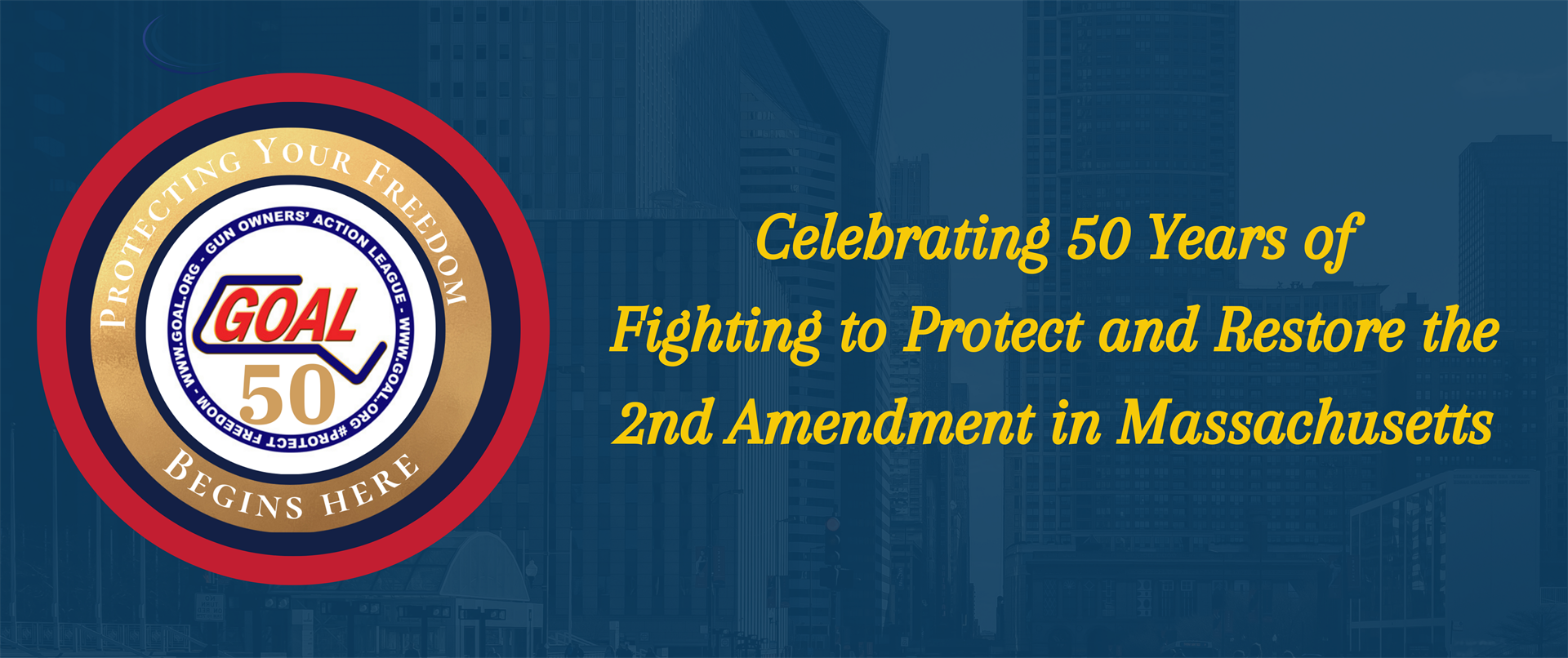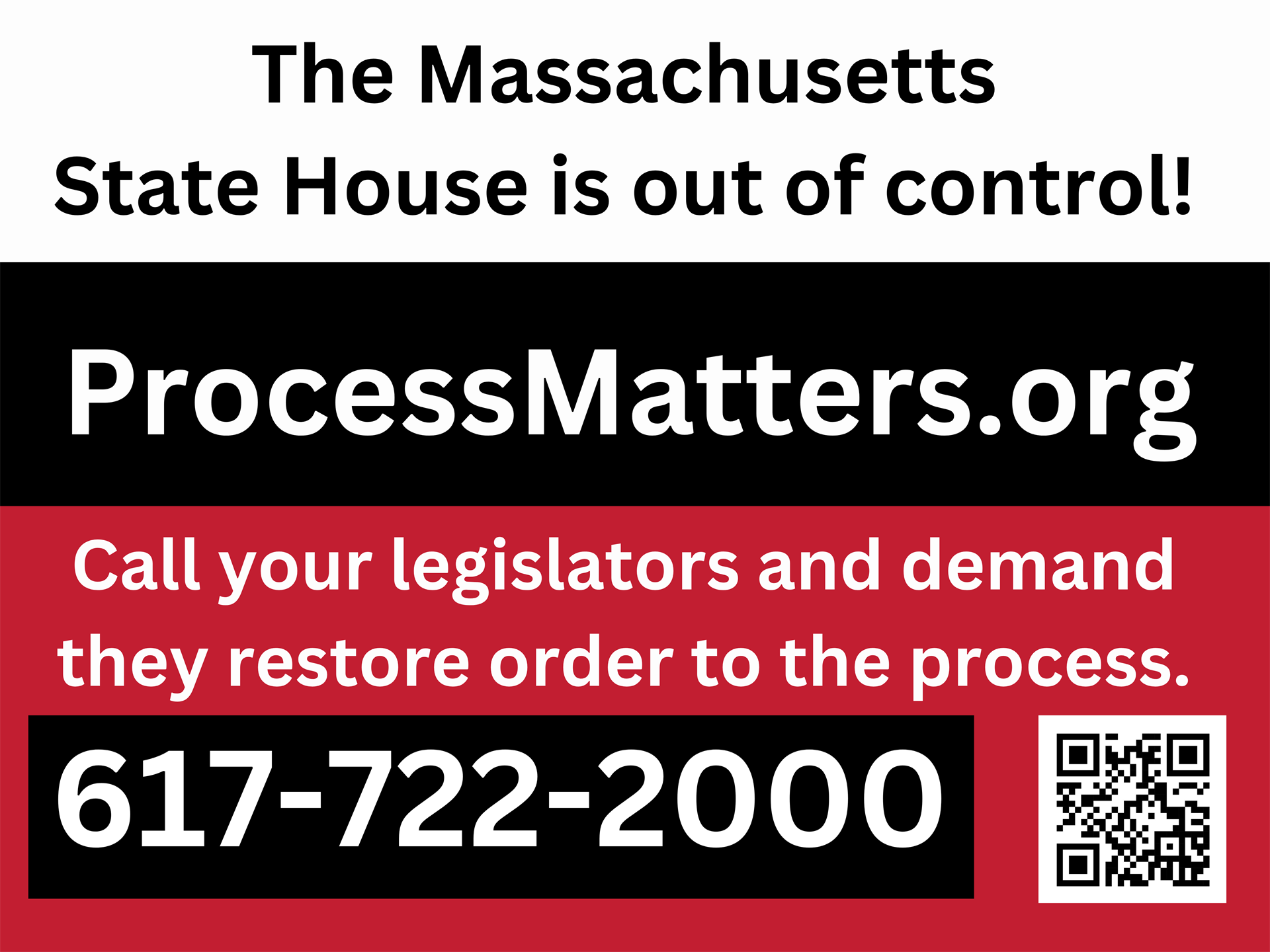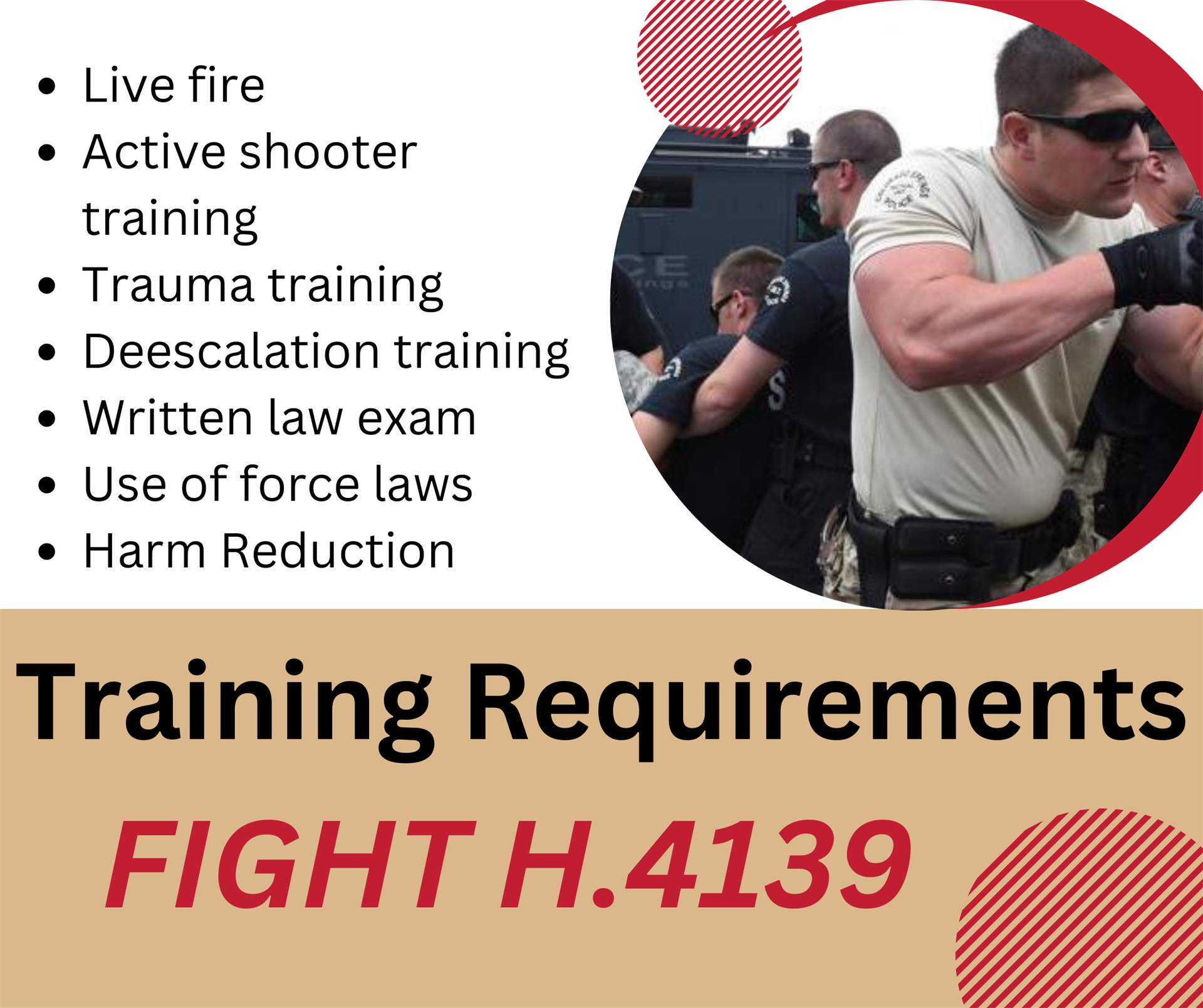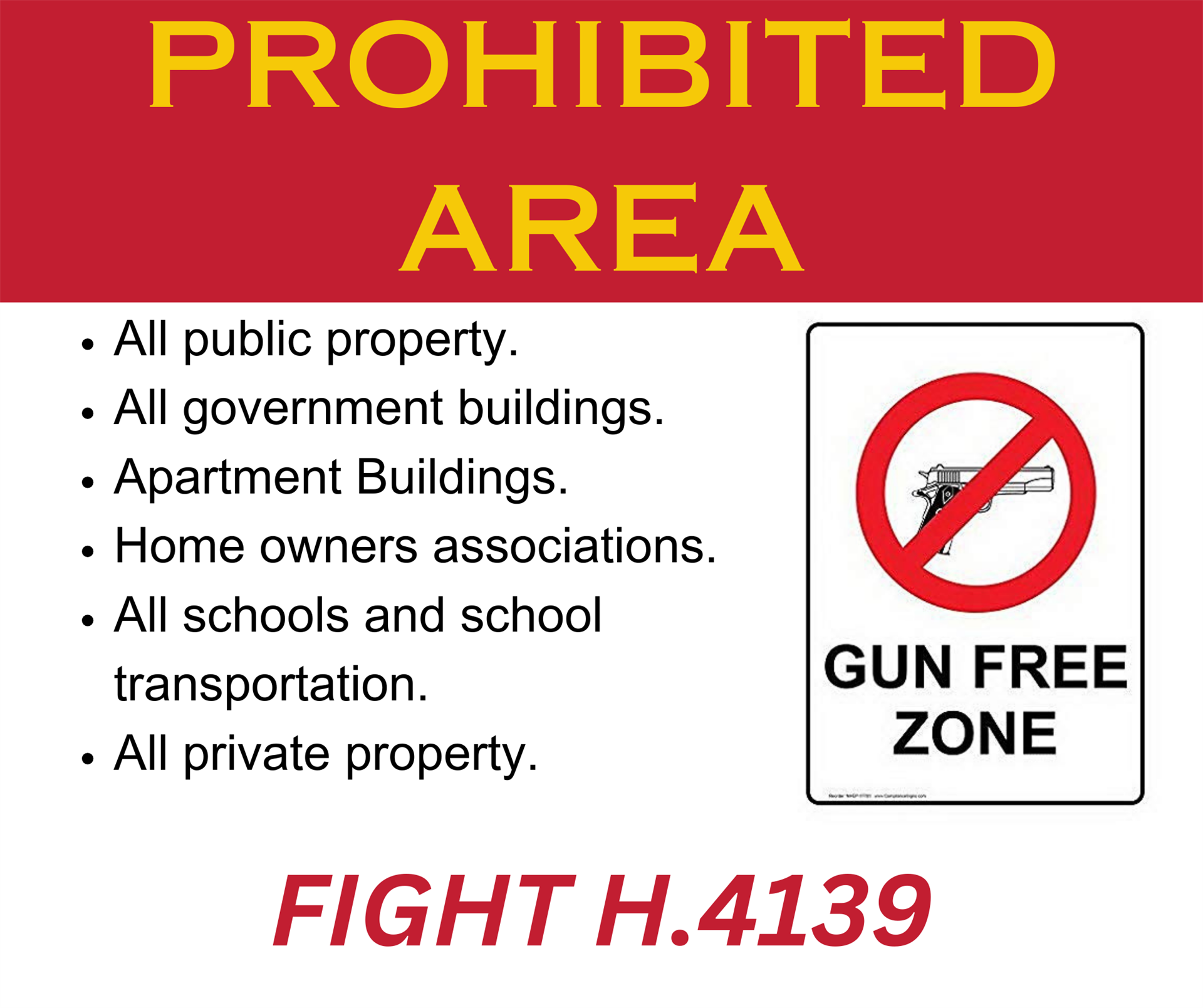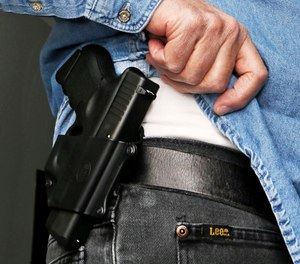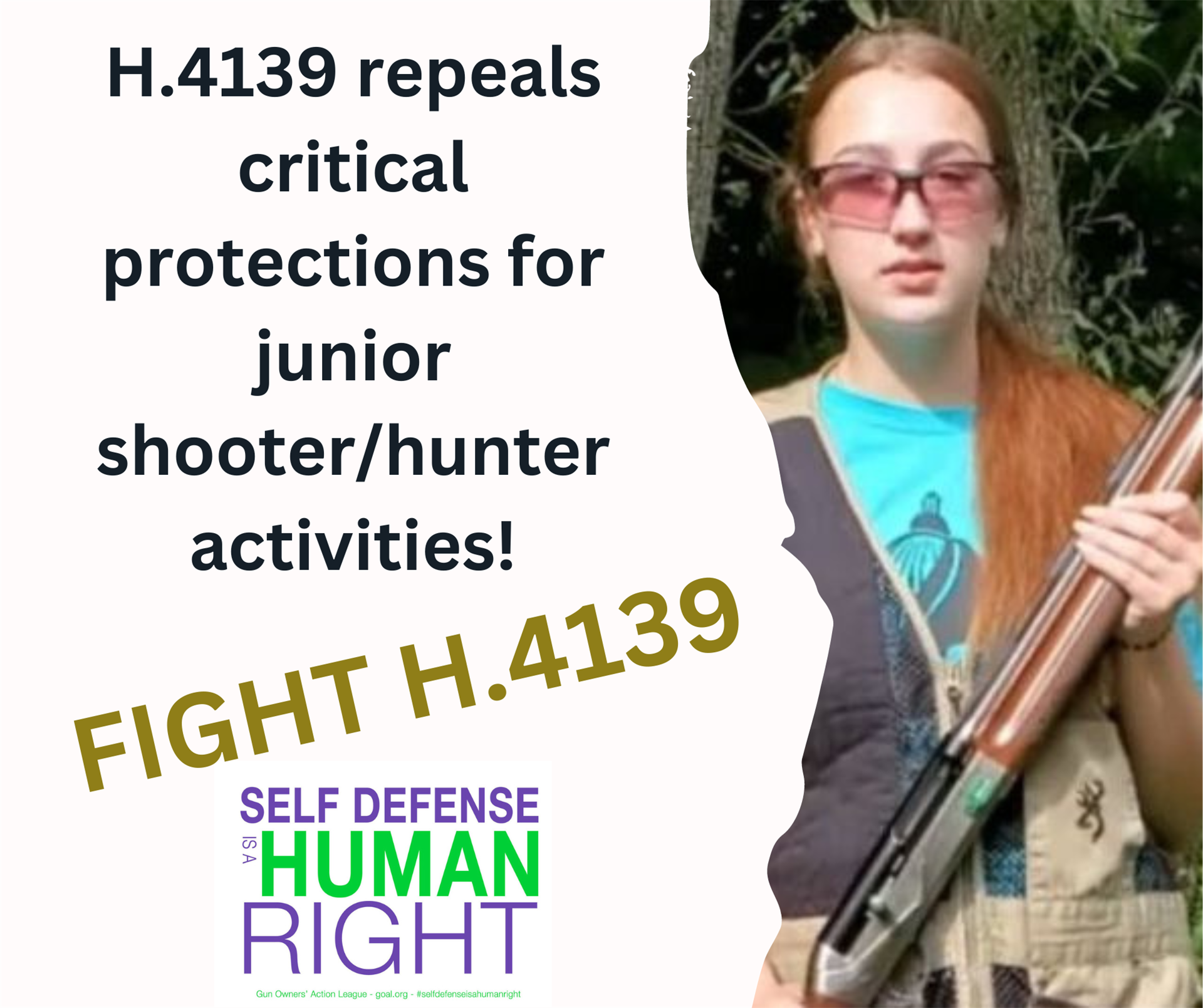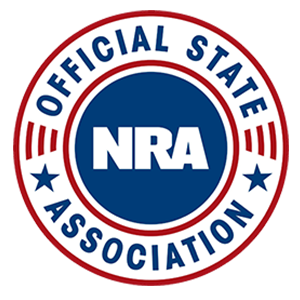- Home
- Advocacy & Legislation
- 2023 Gun Ban Bill
H.4139 (HD.4420) on the move again!
Use our sample Email/Letter Language and Information
Check out the ProcessMatters.org page!
Compilation by Subject Matter of the House and Senate Language Combined
Click Here to See the Complete Disregard for Legitimate Legislative Process
The Massachusetts House and Senate did not agree on a version of the "Lawful Citizen's Imprisonment Act". As a result, each named their members of the "Conference Committee" (See explanation below.)
GOAL is urging all of our members to contact the Conferees and oppose any new restrictions on lawful citizens! There is nothing in any of the language that will reduce violent crime or address the mental health epidemic.
- At some point the Conference Committee will begin the process on developing a bill that the House and Senate can agree on.
- There is no set schedule on negotiations, they could begin to meet tomorrow or months from now.
- The only deadline is July 31, 2024 - the end of formal sessions.
- All work the Committee does will be done in secret.
- The public is not allowed to attend or even listen to deliberations.
Conferee's Full Contact Information
(617) 722-1639 24 Beacon St. (617) 722-1410 24 Beacon St. (617) 722-1600 24 Beacon St. | (617) 722-2396 24 Beacon St. (617) 722-2230 24 Beacon St. (617) 722-2810 24 Beacon St. |
Compilation by Subject Matter of the House and Senate Language Combined
- House Rejects Senate Bill and Appoints Conference Committee Members
- Summary by Subject Matter - S.2584
- Summary .pdf Version
- Official S.2584 Language
- Final Roll Call Vote on the Senate Bill
- Senate Roll Call Vote on Sending the Bill to Committee
- Senate Amendment List
- Senate Amendment Roll Calls (Only Four)
Conference Committee Explanation
When a stalemate develops between branches over an amended Bill, a Conference Committee is established to try to resolve the disagreement. A Conference Committee is made up of three legislators from each branch, chosen by the Speaker of the House and the Senate President. Two of the members are chosen from the majority party; the remaining member is selected from a minority party. Usually, the Chairperson of the Committee where the Bill originated from is selected as the Chairperson of the Conference Committee. This selection is often made to acknowledge the Chairperson's expertise and knowledge of the subject area.
Conference Committee members are expected to uphold the position of their prospective branches. However, each Conference Committee is responsible for working out a compromise that both branches can agree upon. Once a majority of Conference Committee members reach an agreement a Conference Report is sent to the floor from which the Bill originated. A Conference Report cannot be amended; it can be only accepted or rejected by this branch and sent to the other branch for acceptance or rejection. Conference Reports that are accepted by both branches are sent to the Governor for signature or veto. Rejected Conference Reports are sent back to the Conference Committee for further negotiations.
HD.4607 Testimony Videos
GOAL Staff HD.4607 Testimony Video
Kerrie Ann Auclair's Testimony Video
MA Chiefs of Police Testimony Video
Gun Owners’ Action League
H.4139 – Breakdown by Subject Matter
October 23, 2023
This should only be considered a basic breakdown of the new bill. By no means does this reflect every detail contained in the bill’s language. It should merely serve as an abbreviated summary.
The “Section #s” refer to the sections of the bill NOT the new sections of law should it pass.
Assault Style Firearms (Previously “Assault Weapons”) (Sections 20, 51)
The new definition described here would essentially take all semi-auto long guns out of the “guns in common use” that are protected items via Bruen and other cases.
The new version does provide some limited grandfathering. However, it is very confusing as it separates pre-1994 and a new August 1, 2024 rule. The pre-1994 language places very confusing strict language on where the items can be possessed.
It still includes a massive list of newly banned guns. It does seem to exclude rimfire guns.
The language would literally ban all muzzle devices including flash suppressors, muzzle brakes, compensators, etc.
The “one feature test” for semi-autos is still present in this version. In addition to a detachable magazines it still includes the old features, this would include:
• thumbhole stocks,
• shroud that encircles either all or part of the barrel designed to shield the bearer’s hand from heat, excluding a slide that encloses the barrel,
• A forward grip or second handgrip or protruding grip that can be held by the non-trigger hand.
Grandfathering for possession within the commonwealth on August 1, 2024 *It is unclear if transferring is OK.
New pre-September 13, 1994 rules for certain guns and magazines
o On private property owned or legally controlled by the person.
o On private property that is not open to the public with the express permission of the owner or owner’s authorized agent.
o While on the premises of a licensed firearms dealer or gunsmith for the purpose of lawful repair.
o At a licensed firing range or sports shooting competition venue.
o While traveling to and from these locations; provided, that the large capacity feeding device is stored unloaded and secured in a locked container.
o A person authorized under this chapter to possess a large capacity feeding device may only transfer the device to an heir or devisee, a person residing outside the commonwealth, or a licensed dealer.
Common Long Gun (Section 21, 45)
This definition specifically excludes any type of semi-automatics. It would ban the purchase, and possession of a semi-automatic for anyone under 21.
The only exemption for anyone under 21 to possess a large capacity firearm or semiautomatic rifle or shotgun is under the direct supervision at a licensed club. That means no semi-automatics for anyone under 21 for hunting and use at unlicensed clubs.
Curio and Relic (Section 23, 48)
Someone licensed as a bona fide collector can only purchase any type of firearm through a licensed Massachusetts retailer. It seems to eliminate private transfers under this type of license.
New Definition - “Curio or relic firearms”, firearms which are of special interest to collectors because they possess some qualities not ordinarily associated with firearms intended for sporting use or as offensive or defensive weapons.
Defensive Sprays (Section 34, 45)
Creates a separate pepper permit for 15 – 18-year-old persons with parental consent.
There is no fee for the permit in the bill.
A long gun permit does not allow persons under 18 to possess pepper spray.
Exemptions to Various Sections
• Reduces the time an heir of an estate has to transfer firearms and ammunition from 180 days to 60 days.
• Restricts the possession of a firearm or ammunition of an unlicensed person while under direct supervision by a licensed person inclusive only for a “particular purpose and limited time”, but it doesn’t define what that purpose or time is.
• Exempts professional photographers, writers and other media/movie/theater staff under certain circumstances.
• Restricts signaling/distress devices to over 18.
Firearm Control Advisory Board (Section 49)
Changes the makeup and duties of the current Gun Control Advisory Board. The director of the firearms record bureau, current member, but will now serve as the chair.
It adds the following members:
• The attorney general or designee.
• 1 member appointed by the speaker of the house of representatives.
• 1 member appointed by the president of the senate.
• 2 members appointed by the governor, 1 of whom shall be a member of the gun owners action league and 1 of whom shall be a police chief selected from a list of four chiefs provided by the Massachusetts chiefs of police association.
• The armorer of the department of state police or designee.
New Duties
• Advise the state on firearm control provisions of this chapter,
• Advise the state on training needs and materials for licensing authorities and all license holders.
Gun Use Data (Section 41)
It requires the state to gather a huge list of data points on the legal and criminal use/possession of firearms and make that data available to the public.
Large Capacity Feeding Device (Section 27, 51)
The new definition of this includes - Any part or combination of parts from which a device can be assembled if those parts are in the possession or control of the same person. So, apparently if you have a box and a spring there is a crime.
Large Capacity Firearm (Section 21, 28, 47)
• No person shall possess a loaded firearm in a vehicle unless the firearm is under the direct control of the person.
• No person shall possess a large capacity firearm or machine gun in a vehicle unless it is unloaded and secured in a locked container.
• Exemptions for law enforcement and other government agents within their “official duties” only. This negates the exemption in the “Prohibited Area” section if their service firearm is large capacity.
• Military and law enforcement cannot possess large capacity firearms off duty.
Any semiautomatic that has a fixed large capacity feeding device.
A semiautomatic and capable of accepting, or readily modifiable to accept, any detachable large capacity feeding device when both are in the same person’s possession or under their control in a vehicle.
Licensing Authority (Section 29)
If a municipality does not have a licensing chief or officer, the applications will be handled by the State Police. It is not clear if that means the local can just opt out and hand it over the State Police.
Licensing/Prohibited Persons (Section 44)
Removes the 90-day grace period for expired licenses.
Adds to the prohibited list a Biden initiative for anyone who had an appointed guardian or conservator.
It also reaffirms “suitability” in an apparent violation of Bruen. Suitability will not apply to a “long gun permit” unless the licensing authority petitions a court.
Mandatory Registration (Section 39)
Mandates the serialization and registration of all firearms possessed, manufactured or assembled in Massachusetts.
No exemptions for pre-serialization firearms unless it is considered an antique.
It specifically excludes nonresidents passing through but must meet Massachusetts storage requirements.
A new requirement is to report the “loaning” of a firearm.
It appears that retailers would have to register any new inventory within seven days.
Mandatory Firearm Safety Training (Section 47)
Only the state, not the instructor, can actually issue a certificate of training.
The taking of a Hunter Education course is the only exemption from the new requirements, but only for a “long gun” license.
Mandatory curriculum developed by the state police must include:
o The safe use, handling and storage of firearms.
o Methods for securing and childproofing firearms.
o The applicable laws relating to the possession, transportation and storage of firearms.
o Knowledge of operation, potential dangers and basic competency in the ownership and use of firearms.
o Injury prevention and harm reduction education.
o Active shooter and emergency response training.
o Applicable laws relating to the use of force.
o De-escalation and disengagement tactics.
o Live firearms training.
Mandatory Licensing Authority Training (Section 47)
The language once again places mandatory training requirements on law enforcement with heavy penalties for noncompliance. Including licensing responsibilities; record keeping obligations, firearm surrender, registration, and tracing etc.
Mandatory Firearm Retailer Training (Section 47)
Any person applying for a retailer license or renewal must complete a training program that includes at minimum:
• Uniform standards of security for business premises.
• Employee background check and training requirements.
• Information on requirements and conditions as deemed relevant to the state.
Manufacturer Liability (Section 52)
There is a backdoor manufacturer liability under the “safety devices” section. It seems to open the door for accidental or self-inflicted injuries for anyone under 18.
Nonresidents (Section 30, 45)
Nonresident licenses will only be issued for purposes of:
o A firearm competition.
o A nonresident who is in the employ of a bank, public utility corporation, or a firm engaged in the business of transferring monies, or business of a similar nature.
o A firm licensed as a private detective whose application is endorsed by an employer.
o A nonresident who is a member of the armed services and is stationed within the territorial boundaries of the commonwealth and has the written consent of their commanding officer.
• Nonresident law enforcement prohibited from possessing “assault style firearms”.
• A nonresident at least 18 years and can only possess common long guns and ammunition if the nonresident has a permit or license issued from their state of residence. That license must meet requirements of a Massachusetts license with the following exemptions.
o to hunt during hunting season with a nonresident hunting license or a hunting license or permit lawfully issued from their state of residence which has substantially similar requirements to those in section 11 of chapter 131;
o while on a firing or shooting range
o while traveling in or through the commonwealth, provided that they are unloaded and secured in a locked container
o while at a firearm showing or display organized by a regularly existing gun collectors’ club or association.
• Nonresident Junior shooters/hunters under 18 cannot possess a pistol or revolver for any purpose.
• Nonresidents traveling in or through the commonwealth for the purpose of hunting, they also have on their person a hunting or sporting license issued by the commonwealth or by their destination state.
• A nonresident may carry a firearm on their person while in a vehicle lawfully traveling through the commonwealth, provided, however, that the firearm may not leave the vehicle and if the firearm is outside its owner’s direct control it must meet safe storage requirements.
Private Transfers (Section 48)
• Adds ammunition to the limit of four private transactions per calendar year.
Prohibited Areas (Section 92)
• A place owned, leased, or under the control of state, county or municipal government and used for the purpose of government administration, judicial or court administrative proceedings, or correctional services, including in or upon any part of the buildings, grounds, or parking areas thereof. This can include:
o A provision in any private rental or lease agreement restricting a party’s or a tenant’s possession or use of firearms on the property or in the residential dwelling.
o A restrictive covenant restricting the possession or use of firearms on the property or in the residential dwelling.
o Any homeowners’ association, community association, planned community association, condominium association, cooperative, or any other nongovernmental to restrict the possession or use of firearms on private property.
• A location in use at the time of possession as a polling place or for the storage or tabulation of ballots.
• An elementary school, secondary school, college or university including transport used for students of said institution, including in or upon any part of the buildings, grounds, or parking areas.
• Any private, residential dwelling of another, not held open to the public, unless the person in possession of the firearm:
o has a valid firearms license or permit issued under sections 124 to 124B, inclusive, of chapter 140; and
o has been given express authorization to carry a firearm in said dwelling by the property owner or lessee, or an agent thereof; provided, that express authorization shall be signified by unambiguous written or verbal authorization or by the posting of clear and conspicuous signage on the building or the premises by the property owner or lessee, or an agent thereof, indicating that possession of a firearm is authorized.
Exemptions/Additional Provisions of Prohibited Areas:
• State-owned public land available to the public for hunting shall not be a "prohibited area". There are a lot of lands that are managed by the state, not owned, that are currently open to hunting.
• It shall be a defense to a violation of this subsection that a person with a license or
permit securely stored the licensed firearm in a vehicle while within the prohibited area.
• Active law enforcement officer while in performance of their official duties or to a security guard employed at the prohibited area while at the location of their employment and during the course of their employment.
• Law Enforcement are exempt in their “personal capacity” only if carrying their service firearm.
• Does not apply to firearms authorized by a secondary school, college or university, with prior written notice to the department of state police, to be possessed or stored on school grounds.
o Does not limit the authority of any municipality, county or department, division, commission, board, agency or court of the commonwealth to adopt policies further restricting the possession of firearms in areas under their control.
Receiver Definition (Section 26, 32)
A frame or receiver will be considered a firearm and must meet the serialization and registration requirements.
The bill includes a new definition of “Receiver” as the part of a rifle or shotgun that provides housing or a structure for the primary component designed to block or seal the breech prior to initiation of the firing sequence, even if pins or other attachments are required to connect such component to the housing or structure.
Red Flag Laws (See separate summary)
Massive expansion of these laws. Somewhere around 8 sections. Drastically expands the people who can file a petition against a lawful gun owner and other provisions that we still need to go over in detail.
Retailers (Section 46, 47)
• Creates Uniform standards of security for business premises.
• Applies “suitability” to retailer licenses.
• Must complete online retailer training.
• Must post information on safe storage and transportation.
• If a retailer is given an expired, suspended or revoked license or permit they must:
o immediately report all firearm transfers and transactions,
o confiscate the license,
o issue the license or permit holder a receipt,
o notify the person of their duty to surrender all firearms and ammunition.
• Must keep onsite records that are open to inspection by police.
• Must report and keep records of any sold, rented, leased or otherwise transferred firearm or feeding device or ammunition.
• Record whether the firearm, feeding device or ammunition has been sold, rented or leased.
• Any purchaser, renter or lessee’s must personally write their name in the sales record book and as confirmed by valid state or federal identification.
• Annual retailer inspections by the State Police including records, inventory & policies and procedures.
Secured Locked Container/Safe Storage (section 34, 47)
At a minimum the container must be capable of being unlocked only by means of a key, combination or similar means, including in an unoccupied motor vehicle, a locked trunk not accessible from the passenger compartment, a locked console or locked glovebox.
It shall be unlawful to store or keep any firearm in any place unless such firearm is secured in a locked container as defined in section 121 or equipped with a tamper-resistant mechanical lock or other safety device, properly engaged so as to render the firearm inoperable by any person other than the owner or other lawfully authorized user. For purposes of this section, such firearm shall not be deemed stored or kept if carried by or under the direct control of the owner or other lawfully authorized user.
Serial Numbers (Section 35, 40)
Mandates the serialization of all firearms (includes frames and receivers). No exemptions for non-serialized collectibles unless they are legally considered an antique.
Requires new residents moving into the commonwealth or acquired by heirs must be serialized within 60 days and registered.
Prohibits assembling a privately made firearm without obtaining a unique serial number from the department of criminal justice information services prior to manufacture or assembly.
The language places limitations on who can apply serial numbers to a federally licensed firearms manufacturer, importer, or dealer who is authorized by federal law to serialize firearms, or a serial number issued by the director of the Bureau of Alcohol, Tobacco, Firearms and Explosives in the United States Department of Justice or the department of criminal justice information services.
It also set standards for serialization including - must be placed in a manner not susceptible of being readily obliterated, altered or removed. Anything made from non-metallic materials must have a metal plate permanently embedded in the material of the frame or receiver.
Stun Guns (Section 26, 45)
Stun guns would have to meet serialization and registration requirements.
Stun guns are exempt from training requirements, rosters and “smart gun mandates”.
Must meet safe storage requirements as they are considered a firearm.
Triggers (Section 36, 86)
A ban and definition of “Trigger modifier”, any modification that repeatedly activates the trigger of a firearm including, but not limited to, trigger cranks, binary triggers and hellfire triggers.
